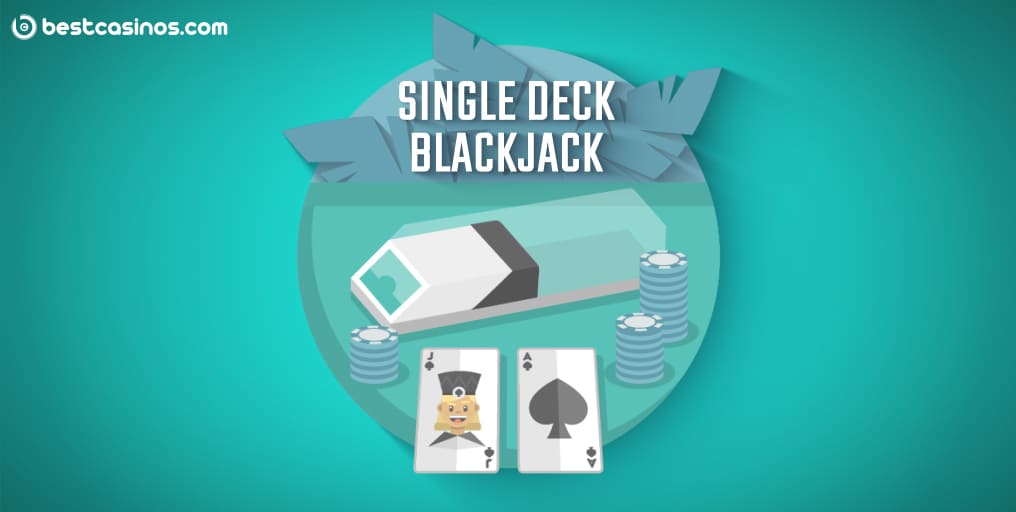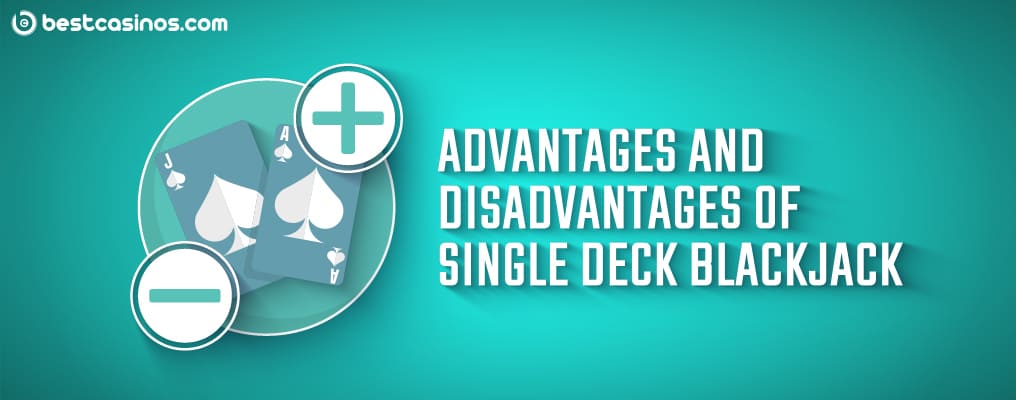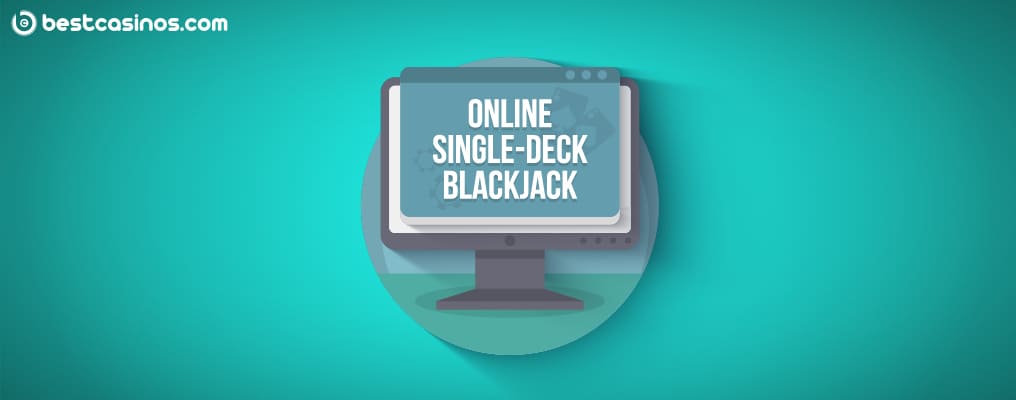
An Ultimate Guide to Single-Deck Blackjack Gaming
Is single-deck blackjack superior to all other blackjack variants? And if yes, what makes it such a great option for you?
Welcome to our single-deck blackjack guide, where we bring you everything there is to know about the exciting 1-deck blackjack. Our comprehensive guide includes payouts, rules, the best single deck blackjack strategy, tricks, and more! Scroll down to learn special tips that will enhance your proficiency and buff up your casino experience.
Table of Contents
- What Is Single Deck Blackjack?
- Key 1-Deck Highlights
- How to Play Single-Deck Blackjack
- Advantages & Disadvantages of Blackjack One Deck Games
- Is Single-Deck Blackjack Better Online?
- Top Three Single Deck Blackjack Tables To Play for Real Money
- Optimal Single Deck Blackjack Strategy
- Card Counting in 1-Deck Games
- Single Versus Double Deck Blackjack
What Is Single Deck Blackjack?
Single deck blackjack is a game of blackjack played with only one deck of cards. A famous trait of 1-deck tables is that the first cards are dealt face-down. Most variants today feature 6 or 8 decks, but single and double deck blackjack games remain as popular as ever. The reason for their popularity lies in the lower house edge of 0.15% and high RTP rates.
There’s also the benefit of card counting – it’s much easier to count cards in one deck blackjack games than with more decks.
So, in short, this variant uses one deck card, which is reshuffled before the start of each round. However, casinos often devise ways to even out the difference between the house and players because of its lower edge. That’s why in 1-deck games, the dealers hit on soft 17 but stand on hard 17. When it comes to basic game rules, you are allowed to split Aces but not re-split them. Split Aces also would not make a blackjack (21) if paired with a card valued at 10.
When it comes to splitting other pairs, you can do so up to three times per hand.
Other than these specific rules, most things remain intact. Thus, for example, blackjack pays 3:2, while the notorious Insurance pays 2:1.
Key 1-Deck Highlights
- Played with one card deck
- Standard blackjack rules apply
- First two cards are dealt face-down
- The dealer hits on soft 17
- Splits are allowed up to three times per hand
- Splitting Aces is allowed, but not re-splitting
- A Split Ace + 10 is not considered a blackjack
- Blackjack pays 3:2
- Insurance pays 2:1
How to Play Single-Deck Blackjack
The best part about playing blackjack for real money online is not about winning large sums, although that’s certainly a good incentive. Rather, the greatest thing about it is the diversity that comes with each new variant.
Blackjack famously has a low house edge, which makes it perfect for both casual players and advantage gamblers. But how do you increase your advantage and lower the edge? Well, strategies do help, but you can also pick better variants that decrease the house advantage. Single-deck blackjack is one of them.
To play blackjack with one deck, you really don’t have to learn new rules or burden yourself with complex strategies. Instead, you only need a rudimentary knowledge of basic blackjack rules, with several slight additions that come with the one deck setting.
The goal of the game is to collect cards whose total value reaches 21. You are automatically the winner of 3:2 payouts when you reach it while going over means loss. However, even if you don’t reach 21, you can still win. Get a higher hand than the dealer, and you are the winner of the round. Another option is to Stand and wait for the dealer to go bust (go over 21).
Here is what a typical round looks like with one deck:
- You start by placing a wager on the round.
- The dealer will deal two cards to you (face-down to curb card counting)
- Unless you have a 21, you are offered a chance to Hit (get another card) or Stand. If you have a pair of any kind, you can also Split (create two separate hands using a card from the pair).
- The dealer will then reveal the second dealer’s card.
- You can keep Hitting until you are satisfied with the result or reach 21 (and beyond).
- The dealer is obligated to hit until it reaches a hard 17 or any 18.
- The round ends with the winner getting a payout.
So, you see – playing one-deck blackjack is not different from any other blackjack variant. The only difference is the card shuffle that happens after every round, which means every round starts with a fresh deck.
Advantages & Disadvantages of Blackjack Single-Deck Games

Is it better to play single-deck blackjack?
We often get this question from our readers. They cannot decipher whether this type is good for them or how it compares to other variants. But, there’s a reason for that – basic psychology. We are conditioned to think that the more decks we have, the more options we get. To a certain extent, it’s true – but more options do not translate into more advantages, at least not always.
So, are multi-deck games better than one-deck?
We have to say no. Every variant has its pros and cons, and the same thing applies to single deck blackjack tables. Although, admittedly, this variant has more pros than cons.
The biggest advantage of playing 1-deck blackjack is the low house edge. The edge is only 0.15%, which makes it magnificent! But bear in mind you’ll need an optimal strategy for that one, as the regular blackjack single deck edge without a proper strategy is 0.30%. But still, isn’t that spectacular?
Another great thing about it is the ease with which you can count cards. Yes, dear players, one deck blackjack is perfect for counting cards because there are fewer cards! We will talk about card counting a bit more in the following sections.
The bad side to playing with a single deck is the lack of tables. Unfortunately, blackjack one deck tables are notoriously scarce, as providers nowadays focus more on 6 or 8-deck tables.
Is Single-Deck Blackjack Better Online?

Blackjack is universally acknowledged as one of the greatest gambling games ever. You can find it everywhere – from dusty gaming parlours to high-end lobbies, from small-scale social casinos to powerhouse brands that carry the digital gambling industry. It’s everywhere and in every shape that you can think of.
This brings us to accessibility and advantage. Is it better to play one-deck blackjack online or in-person?
The answer to this question depends solely on the players and their preferences. If you like to play online and visiting land-based casinos is bothersome, digital casinos are the answer to your prayers. On the other hand, you may enjoy playing at brick-and-mortar places more, so forcing yourself to go online is unnecessary.
Some of the advantages of playing single deck blackjack online include 24/7 availability, more tables as land-based casinos feature only a handful of tables in one place, and you can play on your own without bothering other players. This is especially great if you are a novice.
The downside is again the lack of choices, especially in the live casino department. Modern content providers are not focused on these tables, so getting a fresh supply of new tables might be challenging.
Top Three Single Deck Blackjack Tables To Play for Real Money
The sad part of a single-deck experience is that you cannot find as many tables with this functionality as you might like. In the past few years, providers have dedicated significantly more time to multi-deck games, as they offer a better edge for the house, something that suits casinos more.
But we do have a collection of the best single-deck blackjack games that you can play for real money (or for fun) at the best casinos online.
Top 3 Online Single Deck Blackjack Games |
|||||
|
Table of Contents Table Name |
Provider |
RTP |
H17/S17 |
21 Pays |
Where to Play |
| Vegas Single Deck Blackjack | Microgaming | 99.69% | S17 | 3:2 | BitStarz |
| Single Deck Blackjack | Betsoft | 99.62% | S17 | 3:2 | VipSlots |
| Single Deck Blackjack | Play’n GO | 98.76% | S17 | 6:5 | 1xBet |
We made sure to include the RTP rate, the soft and hard 17 rules, payouts for blackjack, and our best casino that hosts the game. As you can see, the first two games are nearly identical, because they have similar RTP rates and identical payouts. However, the Play’n GO table is a bit different, and the most obvious thing is the RTP rate. The rate is lower than usual because the game has a 6:5 payout instead of a player-friendly 3:2. This goes to show that even a tiny change like this can significantly impact the entire game.
Optimal Single Deck Blackjack Strategy
Single deck blackjack is a marvellous choice if you like classic casino games. It doesn’t get more classic than this, trust us!
But, it’s one thing to know the rules and enjoy playing, but another thing entirely if you play to win. To win, you will require a strategy that suits the rules and goes well with your proficiency level.
But bear in mind that you might have to adjust your strategy according to the table rules. Sometimes you will even have to use blackjack deviations, depending on the situation you are in.
Here is what to do if you play a single deck where the dealer hits on soft 17.
- If your hand is 4-7, Hit.
- Hit if you have 8, except if the dealer has 5 or 6. In that case, you should Double Down if you can.
- Double if you can if your hand is 10 or 11. If you cannot, you should Hit.
- For hands that are 12 in total, Hit unless the dealer has 4-6. In that case, you should Stand.
- For hands 12-16, Hit if the dealer has 7+.
- With player hands above 12 against the dealer’s 2-6, the rule is to Stand.
- Soft 13-16 hands against the dealer’s 2 or 3 should always Hit.
- Always Split 8s and Aces.
- Split all 9s except when the dealer has 7 or 10. In that case, you should Stand.
- If the table allows Double-After-Split, split 6s against dealer’s 7, and split 3s and 7s against the dealer’s 8. If you cannot, Hit.
Tables that allow dealers to stand on soft 17 are rare, but you might run into one of these on your gambling adventure. If that is the case, you should use all the rules we mentioned above. The only exception with such tables is that you have fewer opportunities to Surrender (if possible), which we don’t usually recommend anyway.
Single Deck Blackjack Card Counting
Card counting is a superb skill often practised by blackjack masters.
It’s often featured in movies, but what we see in films is often not how reality looks. If anything, it’s far from truth – especially the ‘only a genius can count cards’ trope.
You don’t have to be a mathematical whiz to count them, but you do need to be a proficient player with years of experience.
In actual casinos, counting cards is a tamer practice that includes tracking the Running and True Counts of the game. But because it relies on counting cards, i.e. keeping track of the cards that have passed and those that haven’t, counting cards is easier when there are fewer cards. For example, it’s easier to track 52 or 104 cards instead of 416.
So, single deck blackjack is often considered one of the best variants you can play if you are a counter. In addition, having a single or two decks in a shoe allows easier deck penetration, an essential part of card counting.
How to Count Cards in Single Deck Blackjack
Single deck is a top choice if you count cards, but if you have experience only with multi-deck tables, you have to get used to face-down dealing first.
Namely, the dealers deal the first two cards to players face-down. If you are familiar with double-deck tables, you know the name Pitch Blackjack – the principle here is the same. Casinos do it to discourage punters from counting cards, effectively ruining their Running Count as they cannot know the values of the dealt cards.
But, if you do want to count cards in a single blackjack deck, you need to:
- Pick a math system for assigning values to cards.
- Apply the system by adding/subtracting values as cards are dealt.
- Keep a True Count based on the Running Count.
- Wager according to both counts to maximise winning chances.
A math system refers to a counting system according to which players assign values. The most common one is Hi-Lo because it is both effortless to master and apply.
The Running Count is then calculated by adding and subtracting values as each card passes in the round. Players need to do this quickly as the cards are rarely lingering on the table.
There is one thing to remember with counting cards in a single deck. True Count is not easy to calculate here, but it is necessary so you could know your standing.
One-Deck Blackjack True Count Formula (With an Example)
To get the True Count, you will have to divide by a decimal or fraction.
The True Count has a formula of
Running Count ÷ Remaining Decimal/Fraction of the Deck = True Count
Here is an example. If you have a Running Count of 3 and you are at the middle of the deck (half of the deck has been used in the round), you calculate it like this:
3 ÷ 0.5 = 6
This means that your True Count in this instance would be 6.
Single Versus Double Deck Blackjack
We are big fans of double-deck blackjack. Check out our ultimate double deck blackjack guide if you want to learn more about the exciting Pitch Blackjack.
Although double-deck belongs to the multi-deck variant group, it’s more similar to 1-deck than other variants. They both have low house edges, cards are dealt face-down, and similar rules apply to both of them because of low edges. Moreover, both have fewer cards, which makes them perfect for card counting – and advantage gambling. Another similarity that they unfortunately share is the deficit in terms of tables. As a result, multi-deck games are more common than 1 and 2-deck tables.
When it comes to differences, our list contains only two things – the number of decks and the edge. That’s it. The deck number is self-explanatory. The edge for 1-deck is 0.15%, while 2-deck tables have a 0.23% optimal house advantage.
Similarities
- Low house edge
- The first two cards are dealt face-down (Pitch)
- Suitable for card counting
- Not many tables in casinos
- No Surrender
- May feature similar Blackjack rules such as Hard 17 and no Double After Split (DAS)
Differences
- Single-deck uses only 1 deck or 52 cards
- Double-deck uses 2 decks or 104 cards
- Blackjack one-deck features a 0.15% edge, while 2-deck has 0.23%
Conclusion
Ask any expert, and they will tell you that single deck blackjack odds are among the best casino game odds in the entire industry. This variant is fun to play and exceptionally easy, but there is more to this variant than meets the eye.
Single-deck blackjack has a low edge, great casino odds, and favourable rules that allow you to count cards and win big. The number of the deck(s) affects the profitability of each variant, and having only one is incredibly beneficial to the player. If you haven’t had the chance to try it yet, now is the time. But keep in mind one thing – one-deck blackjack is rare because casinos are well aware of the game’s potential.













BestCasinos team consists of online casino experts dedicated to spreading their knowledge and experience to a wider audience, all in effort to help even the most inexperienced players gain their footing in this exciting industry.